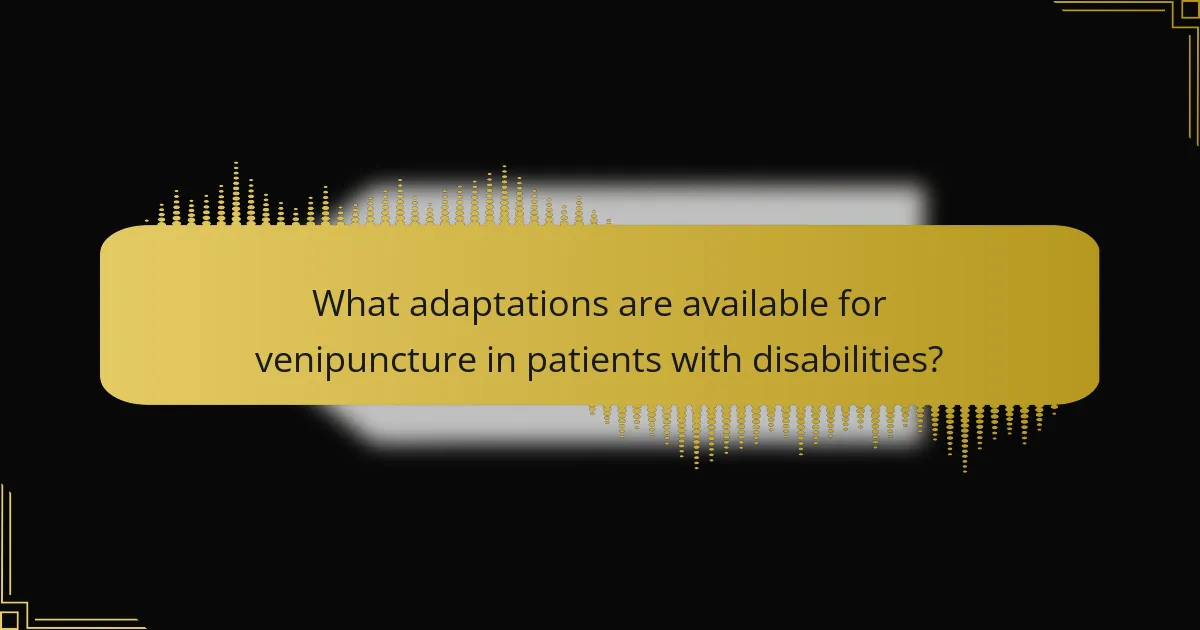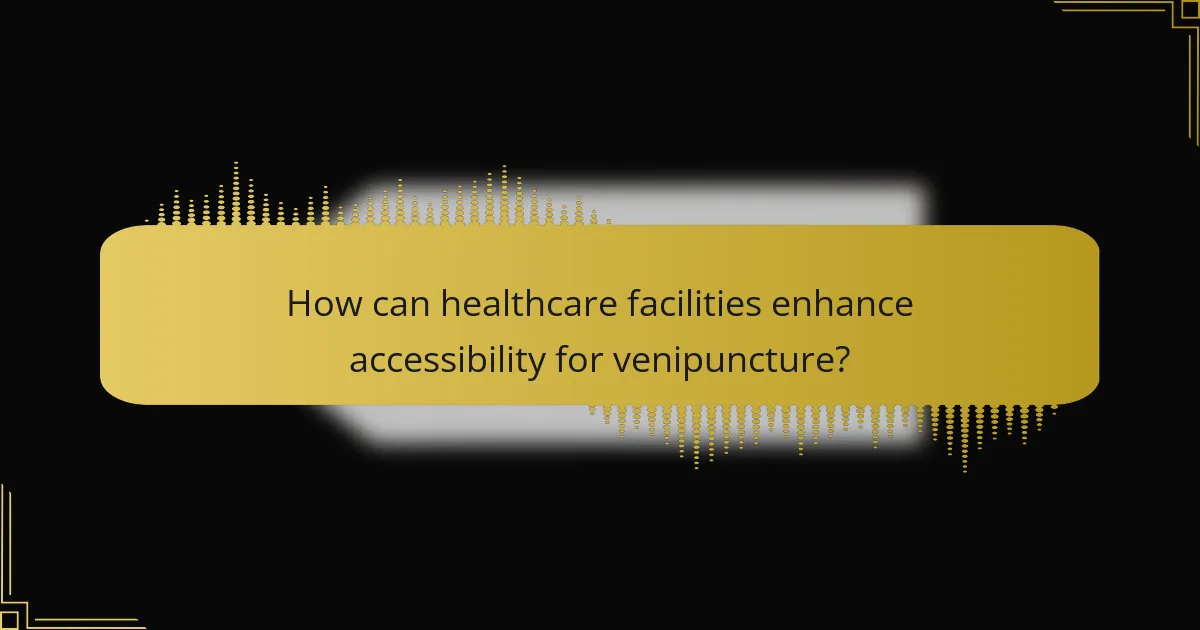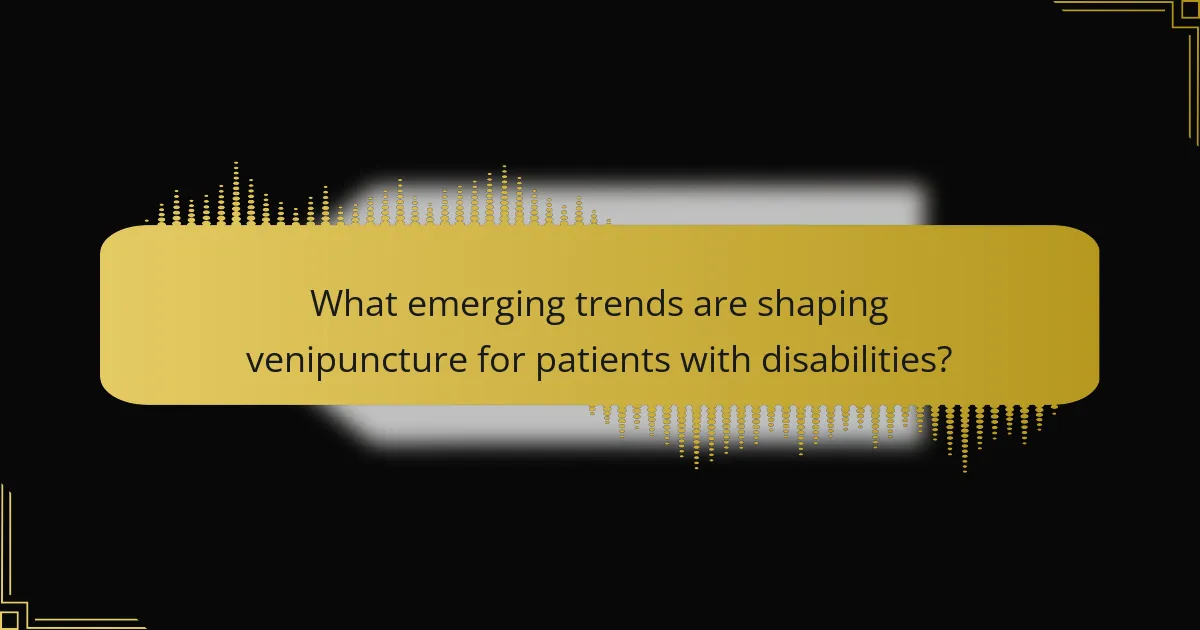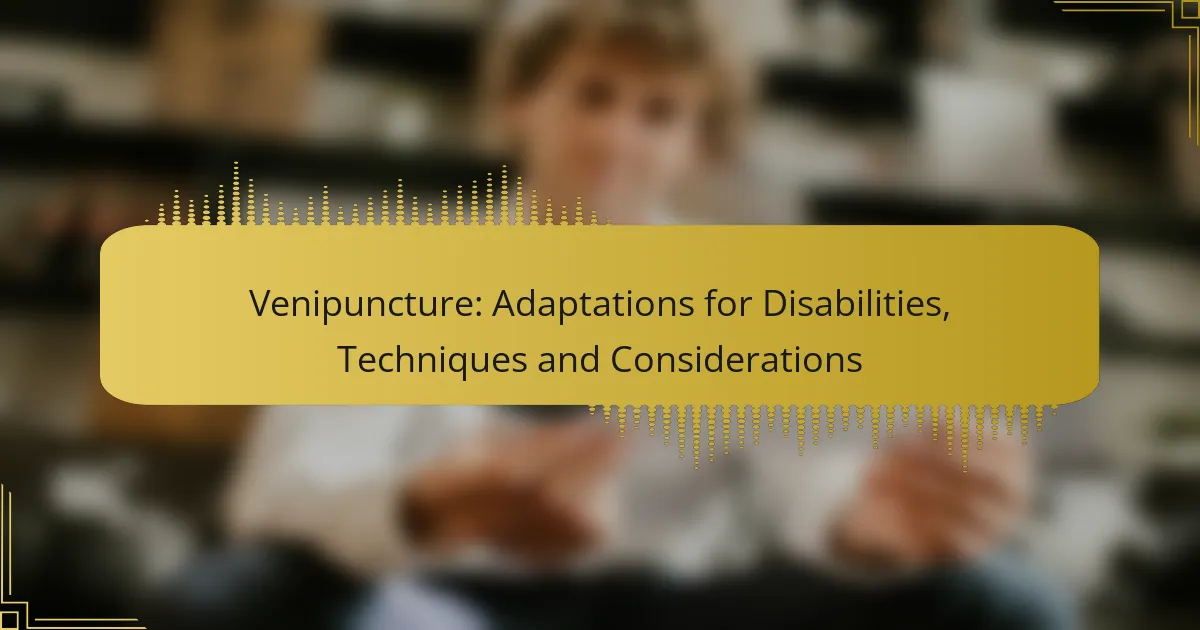Venipuncture for patients with disabilities requires thoughtful adaptations to ensure accessibility and comfort. By employing specialized equipment and techniques, such as ultrasound guidance and proper positioning, healthcare professionals can improve the success rates of blood draws. Additionally, understanding each patient’s unique needs and challenges is essential for a positive experience during the procedure.

What adaptations are available for venipuncture in patients with disabilities?
Adaptations for venipuncture in patients with disabilities focus on enhancing accessibility and comfort during the procedure. These adaptations can include specialized equipment, trained healthcare professionals, proper patient positioning, and accessible clinic environments.
Use of specialized equipment
Specialized equipment can significantly improve the venipuncture experience for patients with disabilities. Devices such as adjustable phlebotomy chairs, which allow for easier access and positioning, and vacuum-assisted blood collection systems can reduce discomfort and anxiety. Additionally, using smaller gauge needles may minimize pain for sensitive patients.
Other tools, like extension tubing or butterfly needles, can also facilitate easier access, especially for patients with limited mobility or those who require frequent blood draws. Ensuring that the equipment is readily available can streamline the process and enhance patient comfort.
Training for healthcare professionals
Healthcare professionals must receive training to effectively perform venipuncture on patients with disabilities. This training should include techniques for handling various disabilities, understanding the unique needs of these patients, and practicing empathy and patience during the procedure. Knowledge of adaptive techniques can help professionals feel more confident and competent.
Regular workshops and continuing education programs can keep healthcare providers updated on best practices and innovations in venipuncture for patients with disabilities. This ensures that they are equipped to provide the best care possible.
Patient positioning techniques
Proper patient positioning is crucial for successful venipuncture, especially for those with disabilities. Techniques such as using pillows or cushions to support limbs can help patients feel more comfortable and stable during the procedure. For individuals in wheelchairs, utilizing adjustable armrests or lap trays can facilitate easier access to veins.
Healthcare providers should assess each patient’s specific needs and preferences when determining the best positioning. This personalized approach can enhance the experience and improve the likelihood of a successful blood draw.
Accessibility considerations in clinics
Clinics must prioritize accessibility to accommodate patients with disabilities during venipuncture. This includes ensuring that facilities are wheelchair accessible, with ramps, wide doorways, and appropriate seating arrangements. Clear signage and trained staff can further assist patients in navigating the clinic environment.
Additionally, clinics should consider the layout of the phlebotomy area, ensuring that equipment and supplies are within reach for both patients and healthcare providers. Creating a welcoming atmosphere can help reduce anxiety and improve the overall experience for patients with disabilities.

What techniques improve venipuncture success rates?
Several techniques can enhance the success rates of venipuncture, particularly for individuals with disabilities. Utilizing advanced methods such as ultrasound guidance, vein finders, and proper site selection can significantly increase the likelihood of successful blood draws.
Ultrasound-guided venipuncture
Ultrasound-guided venipuncture involves using ultrasound imaging to visualize veins before insertion. This technique is particularly beneficial for patients with difficult venous access, such as those with obesity or chronic conditions that affect vein visibility.
By providing real-time images, ultrasound allows practitioners to select the best vein and avoid complications. Training in this technique may require additional time and resources, but the increased success rates often justify the investment.
Use of vein finders
Vein finders are devices that use infrared light to illuminate veins, making them more visible through the skin. These tools can be especially useful for patients with darker skin tones or those with small or deep veins.
When using vein finders, it is essential to ensure the device is properly calibrated and that the area is adequately prepared. While these devices can improve success rates, they should be used as a complement to traditional techniques rather than a replacement.
Proper site selection
Choosing the right site for venipuncture is crucial for success. Common sites include the median cubital vein, which is often the easiest to access, and the cephalic or basilic veins as alternatives.
Factors to consider when selecting a site include the patient’s anatomy, previous venipuncture history, and any visible signs of scarring or damage. Practitioners should avoid areas with inflammation or infection to minimize complications.

What considerations should be made for patients with disabilities during venipuncture?
When performing venipuncture on patients with disabilities, it is crucial to consider their specific needs and challenges. This includes understanding their physical limitations, communication preferences, and potential anxiety related to the procedure.
Communication strategies
Effective communication is essential for ensuring that patients with disabilities feel comfortable during venipuncture. Use clear, simple language and confirm understanding by asking patients to repeat instructions or information back to you. Non-verbal cues, such as gestures or visual aids, can also enhance understanding.
For patients with hearing impairments, ensure that you are facing them while speaking and consider using written instructions or sign language if necessary. Always ask how they prefer to communicate and adapt accordingly.
Managing anxiety and discomfort
Patients with disabilities may experience heightened anxiety during venipuncture due to past experiences or fear of the unknown. To alleviate this, provide a calm environment and explain each step of the procedure beforehand. Allow them to ask questions and express any concerns they may have.
Consider using distraction techniques, such as music or conversation, to help manage discomfort. Additionally, using smaller gauge needles may reduce pain during the procedure, making the experience more tolerable for sensitive patients.
Post-procedure care
After venipuncture, provide clear instructions for post-procedure care tailored to the patient’s abilities. This may include guidance on how to care for the puncture site, signs of complications to watch for, and when to seek further medical attention.
For patients with mobility issues, ensure that they have assistance if needed to avoid falls or injuries while moving after the procedure. Follow up with patients to check on their recovery and address any lingering concerns they may have.

How can healthcare facilities enhance accessibility for venipuncture?
Healthcare facilities can enhance accessibility for venipuncture by implementing design features and practices that accommodate individuals with disabilities. This includes creating physical spaces that are easy to navigate and offering flexible scheduling options to meet diverse needs.
Designing accessible waiting areas
Accessible waiting areas should prioritize ease of movement for individuals with mobility challenges. Features such as wide doorways, ramps, and accessible seating can significantly improve the experience. Additionally, clear signage in large print and braille can help patients navigate the space independently.
Facilities should consider the layout of furniture to ensure that there is ample space for wheelchairs and other mobility aids. Incorporating adjustable-height seating can also accommodate patients who may need assistance or prefer to sit at a specific height.
Implementing flexible appointment scheduling
Flexible appointment scheduling is crucial for accommodating patients with varying needs. Offering extended hours or same-day appointments can help those who may have difficulty attending during standard office hours. This flexibility can reduce stress and improve attendance rates.
Healthcare providers should also consider telehealth options for initial consultations or follow-ups, allowing patients to engage with healthcare professionals without the need for physical visits. This approach can be particularly beneficial for individuals with transportation challenges or severe disabilities.

What are the best practices for training staff in venipuncture adaptations?
Training staff in venipuncture adaptations involves a comprehensive approach that emphasizes both technical skills and sensitivity towards individuals with disabilities. Effective training should include practical techniques tailored to diverse needs, ensuring that all patients receive safe and respectful care.
Incorporating disability awareness in training
Disability awareness is crucial in venipuncture training to foster an inclusive environment. Staff should be educated about various disabilities, including physical, sensory, and cognitive impairments, to understand how these may affect a patient’s experience during venipuncture.
Training programs can include modules on communication strategies, such as using clear language and visual aids, and adapting procedures to accommodate different needs. Role-playing scenarios can help staff practice these skills in a supportive setting.
Hands-on practice with adaptive techniques
Hands-on practice is essential for mastering adaptive techniques in venipuncture. Training should incorporate the use of specialized equipment, such as adjustable chairs or arm supports, which can enhance comfort and accessibility for patients with disabilities.
Instructors should guide staff through various scenarios, allowing them to practice techniques like using smaller gauge needles or employing distraction methods for patients with anxiety. Regular feedback and assessment can help ensure that staff are proficient in these adaptations.

What emerging trends are shaping venipuncture for patients with disabilities?
Emerging trends in venipuncture for patients with disabilities focus on improving accessibility and comfort during the procedure. Innovations in technology, training, and equipment are enhancing the experience for both patients and healthcare providers.
Technological advancements in venipuncture
Technological advancements are playing a crucial role in making venipuncture more accessible for patients with disabilities. Devices such as automated blood collection systems and ultrasound-guided venipuncture tools help locate veins more easily, reducing discomfort and anxiety.
Additionally, mobile applications that assist in tracking patient history and preferences can streamline the process, ensuring that healthcare providers are better prepared to accommodate individual needs.
Training and education for healthcare providers
Training and education for healthcare providers are essential to improve venipuncture techniques for patients with disabilities. Programs that emphasize empathy, communication, and specialized techniques can help staff better understand the unique challenges faced by these patients.
Providers should be trained in adaptive techniques, such as positioning patients comfortably and using appropriate equipment, to minimize stress and enhance the overall experience.
Equipment adaptations and modifications
Equipment adaptations and modifications are increasingly important in venipuncture for patients with disabilities. Adjustable examination tables and specialized chairs can facilitate easier access for both patients and providers, ensuring a more efficient procedure.
Additionally, using smaller gauge needles or devices designed for sensitive skin can help reduce pain and improve patient comfort during venipuncture.
